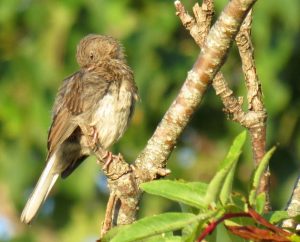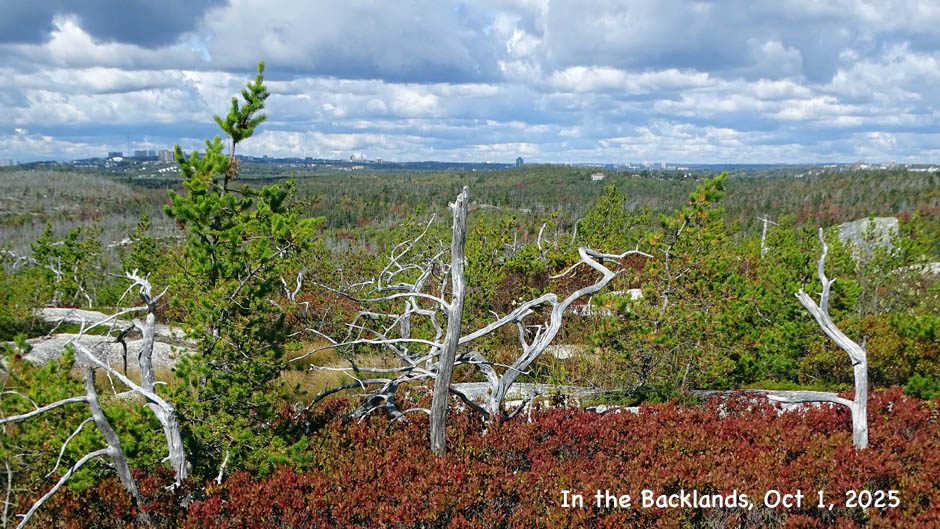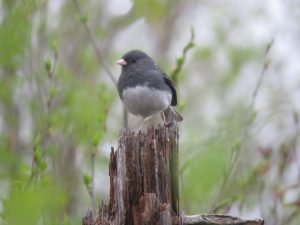Go To Ground-Nesting Birds 2024 for an Intro to this series & Links to other pages
Sep 21, 2024

Another cutie pic of the Juvenile Dark-eyed Junco viewed by JBD in the east Pine Island Pond area on Aug 13, 2022. We’re just coming to the end of the nesting season for 2024.
Did you know that just a few small steps by each of us can make a big difference for ground nesting birds, like the Dark-eyed Junco?
All we need to do is keep our feet on the trails when we’re hiking, especially during nesting season (March – September)
Here are a few more “did you know” fun facts about the Dark-eyed Junco…
– A flock keeps in constant touch with chipping and ticking sounds, with soft trills in flight.
– Once nesting is finished, flocks of Juncos roost overnight in evergreens.
– These birds are known to return to the same breeding areas for many years.
– The oldest Dark-eyed Junco ever found was 11 years old, according to its leg band.
– The juveniles are streaky in appearance before their solid colours appear.
You can enjoy watching these neat and lively birds through every season in the Backlands. Thank you for giving them plenty of room and privacy to nest from March to September, so we can continue to enjoy them for many years to come!
April 18, 2024
This cutie is a juvenile Dark-eyed Junco – you can help ensure they grow into an adult by staying on trails when you’re hiking in the Backlands & other wilderness areas.
How does keeping your feet (& your pet’s feet) on the trail help? Dark-Eyed Juncos nest right on the ground – they make open cup nests of grass and leaves, lined with soft materials like moss. These nests are well hidden underneath foliage or rock, in exposed tree roots, or in small sheltered depressions, making them both difficult to spot & easy to accidentally disturb!
Unlike the American Woodcock (see our last post), both Mommy & Daddy are involved in raising these babies. Mommy Junco lays 3-5 speckled eggs which hatch in about 10 days. Daddy Junco helps feed the young and defend the nest from predators like mice, chipmunks, hawks, shrikes, owls, and feral/domestic cats. Disturbances by people & our pets also interfere with successful breeding.
We’ll be sharing more about 4 of the ground nesting bird species that call the Backlands home…What birds have you been seeing out and about this spring??
April 1, 2024
Its nesting season for the Dark-eyed Junco & you can help…
With nests at ground level rather than in trees, Dark-eyed Juncos could really use a bit of cooperation from us 2-legged visitors to the wilderness – from March 20th to September 23rd, please keep yourself & your pets on the trails to allow these feathered friends to nest & raise their young safely.
Around the Backlands, Dark-eyed Juncos are very familiar visitors to our woods, parks, and backyards, all year round. This small sparrow is dark grey or brown above with a pale belly, and white feathers on the sides of its tail, which flash brightly when it flies.
They flit through small trees and shrubs, often in the company of chickadees, and forage busily on the ground. In the summer almost half their diet is insects, such as caterpillars, beetles or spiders. They also enjoy black oil sunflower and millet seeds at feeders, and in the winter eat the seeds of many grasses and weeds.
Did you see any Dark-Eyed Juncos at your feeder or foraging in your yard this winter? Let us know in the comments.
Check our highlight “Ground Nesting” to hear a clip of a Dark-Eyed Junco singing & to follow along with this series!
– The Ground-Nesting Bird Group:
Joshua Barss Donham, Ilona Inman, Fulton Lavender, Cathy Smalley, Katharine Studholme
Page posted by David P 1Apr2023





